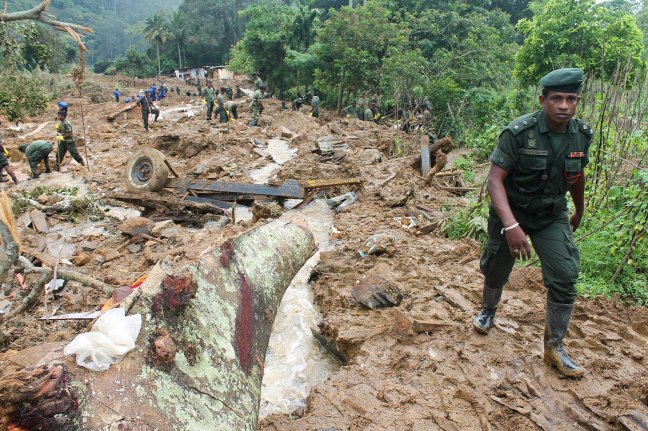The short answer is not only, yes they could but also yes they do, quite regularly. The thing is when we see the word earthquake, what we think of is a major destructive event that topples buildings, opens up cracks in the road, and causes landslides and tsunamis.
But that is only half the truth. Tremors occur on a regular basis. However, most of them are too weak for us to notice them.
True, Sri Lanka sits in the middle of a tectonic plate, well away from either a destructive plate boundary where one plate sinks (subducts) beneath another or a constructive boundary where plates are pulling apart. (see figure 1) And there isn’t evidence of the formation of a transverse fault zone nearby, similar to the San Andreas fault zone pulling apart Southern California.
figure 1 major tectonic plates
However, that doesn’t mean that Sri Lanka is immune to the effects of earthquakes. Many will remember the 2004 tsunami. (the result of a massive earthquake off the western coast of Sumatra)
Then, there was the 2012 earthquake off the coast of Sumatra that sent shockwaves rumbling like an underground train through my apartment in Rajagyria, a suburb of Colombo. The interesting point about that earthquake was that it didn’t happen at a plate boundary but in the middle of the plate; something that is quite unusual.
Now, new research shows that the tectonic plate on which Sri Lanka sits is beginning to split in an area called the Wharton Basin. see figure 2 below. And it was this split that caused the earthquakes measuring 8.6 and 8.9 on the richter scale in 2012.
And researchers suggest that this is happening because different parts of the India-Australia-Capricorn are moving at different speeds, this fracture zone, once just a passive crack, is becoming the new boundary for the plate as it splits into two pieces.
Figure 2 the origin of a new plate boundary
Image credit: Coudurier‐Curveur, A. et al. Geophysical Research Letters (2020)
The rate of separation is very slow, and according to recent research is at some depth, but what detailed studies have revealed is evidence for pull aparts; a series of 64 basins forming where two sections of the plate are sliding by one another, which started to form over 2 million years ago. see figure 3
figure 3 pull apart basin
(Image credit: Coudurier‐Curveur, A. et al. Geophysical Research Letters (2020);)
“It doesn’t seem like it’s yet a fully formed plate boundary, but the take-home message is that it’s becoming one, and it probably accounts for much of the deformation that we know is occurring there.”
William Hawley a seismologist at the Lamont-Doherty Earth Observatory at Columbia University
So this old article in The Sunday Times is worth taking seriously. The point the geologists make is that the highland areas are vulnerable already to landslides so even moderate earthquake activity will only add to the risk. see figure 4
fig. 4 landslide threat to homes (daily mirror)
Great to see that the universities are already researching this; that risk maps and building codes are being considered; maybe tsunami risk and vulnerability also needs looking at.
However, none of this is new. An article in the journal of Natural Science Foundation Sri Lanka 2005 by CB Dissanayake (2005 just after the last Tsunami) wrote about this possible new plate boundary and suggested that “bearing in mind…that the new plate boundary is only 400-500km from its southern shores Sri Lanka perhaps needs to be classified as a moderate earthquake prone area”
Why did this never come out at the time?
No-one was prepared for the 2004 Tsunami which I guess was understandable but forewarned is forearmed so wouldn’t it be good if government agencies could be pro-active and not re-active this time around?
Now that things are more stable maybe it is time for the government to become involved in a positive way by putting their weight behind the ongoing academic research and by taking recent findings seriously. Sri Lanka can’t afford another tectonic disaster.
After all, nothing stalls the development process faster than a major disaster.
Worth a read
https://www.livescience.com/india-australia-plate-tectonics-break.html





There are several changes in terrain starting from Badulla, Bandarawela Kandy ,Trinco ,Galagedara etc . Those can be indications of the parting off of the land mass .
LikeLike
Tell us more; what evidence do you cite; really interested to know
LikeLike
Sorry for the delayed reply. I can’t really add anything
It’s a while since I updated the piece and I guess I picked up the info from a research doc I had read
LikeLike
actually google “sunda subduction asia india convergence” not evidence as such but lots of links, given SL isn’t that far away any major movement along the Sunday plate boundary would likely impact upon SL
LikeLike
There are several changes in terrain starting from Badulla, Bandarawela Kandy ,Trinco ,Galagedara etc . Those can be indications of the parting off of the land mass .
LikeLike
Reply from Colombo Narahenpita ” Manning Town Housing Complex”
Several mild and moderate tremors were detected in the Months of May 2023 and June 2023. During Electrical outages, after heavy Thunder and Lightning Strikes and resultant clean up of clogged storm water drains and gully-manholes.
There were huge decayed tree trunks and dead rats caught up in the culverts near my residential building premises. A very Big Clean up due soon with several damaged clay tiles, soot/moss/fungi growing up along Sun shades, and plenty of mosquitoes hidden in between the cavities of cracked outer walls of the main buildings. Need Regular Monitoring and Effective Remedial Action from well qualified Technical Teams.
Night Illumination very essential now to Protect the Tech Experts studying the Area. Report date 11 July 2023 Colombo Narahenpita
LikeLike